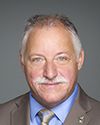I call this meeting to order.
Welcome to the sixth meeting of the Standing Committee on Veterans Affairs.
Pursuant to the motion adopted on February 8, 2022, the committee is meeting to begin its study entitled, Fairness in the Services Offered to Veterans: Francophones and Anglophones, Men and Women, and the LGBTQ+ Community.
Welcome to our colleagues Peter Fragiskatos and Marc Dalton.
Today's meeting is taking place in a hybrid format pursuant to the House order of November 25, 2021. Members are attending in person in the room and remotely using the Zoom application. The proceedings will be made available via the House of Commons website. Just so that you are aware, the webcast will always show the person speaking rather than the entirety of the committee.
Today's meeting is also taking place in a webinar format. Webinars are for public committee meetings and are available only to members, their staff and witnesses. Members enter immediately as active participants. All functionalities for active participants remain the same. Staff will be non-active participants and can therefore view the meeting only in gallery view.
Before speaking, please wait until I recognize you by name. If you are on the video conference, please click on the microphone icon to unmute yourself. For those in the room, your microphone will be controlled as normal by the proceedings and verification officer. When you are speaking, please speak slowly and clearly. When you are not speaking, your mike should be on mute. I will remind you that all comments by members and witnesses should be addressed through the chair.
Regarding the speaking list, the committee clerk and I will do our best to maintain an order of speaking that is fair for all members, whether they are participating virtually or in person.
I would now like to welcome our witnesses.
We have with us, from the Department of Veterans Affairs, Stephen Harris, Assistant Deputy Minister, Service Delivery Branch, and Amy Meunier, Director General, Centralized Operations Division.
Ms. Meunier will make the opening statement.
Ms. Meunier, you have five minutes to make your presentation, starting now.



